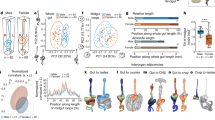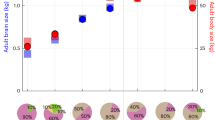Abstract
In thirteen species of fig-pollinating wasps the sex ratios of broods with one or two foundress mothers show qualitative agreement with the optimal sex ratios predicted by local mate competition theory. The deviations from these predictions are not random: for a given number of foundresses, the deviations are least in the wasp species that naturally encounter that number of foundresses most frequently. Furthermore, the difference in sex ratio between broods with one and broods with two foundresses is greatest in those species of wasp in which broods of both type commonly occur. These results show the importance of the selective regime in shaping the evolution of sex-ratio adjustment, and suggest that adaptive behavioural plasticity is more developed in species subject to more variable selective regimes.
This is a preview of subscription content, access via your institution
Access options
Subscribe to this journal
Receive 51 print issues and online access
$199.00 per year
only $3.90 per issue
Buy this article
- Purchase on Springer Link
- Instant access to full article PDF
Prices may be subject to local taxes which are calculated during checkout
Similar content being viewed by others
References
Chamov, E. L. in The Theory of Sex Allocation (Princeton University Press, 1982).
Leigh, E. G., Herre, E. A. & Fischer, E. A. Experientia 41, 1265–1276 (1985).
Endler, J. A. in Natural Selection in the Wild (Princeton University Press, 1986).
Hamilton, W. D. Science 156, 477–488 (1967).
Fisher, R. A. in The Genelical Theory of Natural Selection (Clarendon, Oxford, 1930).
Hamilton, W. D. in Sexual Selection and Reproductive Competition in Insects (eds Blum, M. S. & Blum, N. A.) 107–200 (Academic, New York, 1979).
Herre, E. A. Science, 228, 896–898 (1985).
Frank, S. A. Evolution 39, 949–964 (1985).
Ramirez, B. W. Science 163, 580–581 (1969).
Ramirez, B. W. Evolution 24, 680–691 (1970).
Wiebes, J. T. A. Rev. Ecol. Syst. 10, 1–12 (1979).
Taylor, P. D. & Bulmer, M. G. J. theor. Biol. 86, 409–419 (1980).
Nunney, L. Evolution 39, 349–361 (1985).
Stubblefield, J. W. thesis, Harvard Univ. (1980).
Kjellberg, F. thesis, Inst. National Agronomique, Paris (1983).
Joshi, N. V. & Gadagkar, R. J. Genet. 64, 41–58 (1985).
Berry, J. A. & Raison, R. K. in Encyclopedia of Plant Physiology, 12a (eds Lange, O. L., Nobel, P. S., Osmond, C. B. & Ziegler, H.) (Springer, New York, 1981).
Mantel, L. H. & Farmer, L. L. in The Biology of the Crustacea Vol. 5 (ed. Bliss, D. E.) 53–161 (Academic, New York, 1983).
Author information
Authors and Affiliations
Rights and permissions
About this article
Cite this article
Herre, E. Optimality, plasticity and selective regime in fig wasp sex ratios. Nature 329, 627–629 (1987). https://doi.org/10.1038/329627a0
Received:
Accepted:
Issue Date:
DOI: https://doi.org/10.1038/329627a0
This article is cited by
-
Parasitoid development and superparasitism in invasive versus native widow spider host egg sacs
Biological Invasions (2023)
-
No evidence for adaptive sex ratio adjustment in a cooperatively breeding bird with helpful helpers
Behavioral Ecology and Sociobiology (2023)
-
Pollinating fig wasps’ simple solutions to complex sex ratio problems: a review
Frontiers in Zoology (2022)
-
Genomics of sex allocation in the parasitoid wasp Nasonia vitripennis
BMC Genomics (2020)
-
Moderate parasitoidism on pollinators contributes to population oscillations and increases species diversity in the fig-fig wasp community
Theoretical Ecology (2020)
Comments
By submitting a comment you agree to abide by our Terms and Community Guidelines. If you find something abusive or that does not comply with our terms or guidelines please flag it as inappropriate.



